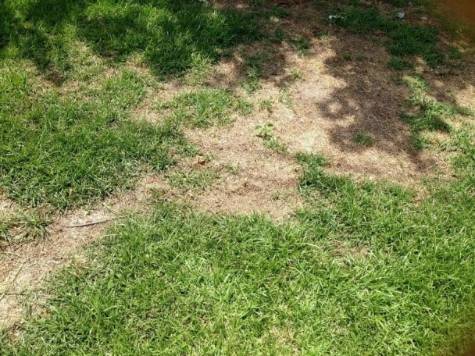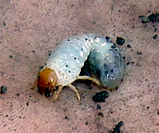Grub Damage

Grubs are small worm-like pests that feed on grass roots and organic material in a home lawn, eventually causing sections of it to die. Grubs are the larval form of several different scarab beetles and are typically fairly easy to see. White grubs are pudgy, off white larvae with a brown head and are typically bent in the shape of the letter “C”. The adult beetles of our white grubs are either Japanese beetles or masked chafers. Japanese Beetles are a  shiny metallic green with wing covers that are coppery red. Masked chafer beetles are tan or straw brown in color and have a black stripe across their eyes and face. The adults beetles typically emerge and begin flying in June and start to lay eggs in July. The grubs feed rapidly and are fully grown in August or September. The grubs then move down in the soil to overwinter before moving back up to the surface of the soil in the late spring to pupate and emerge as adults.
shiny metallic green with wing covers that are coppery red. Masked chafer beetles are tan or straw brown in color and have a black stripe across their eyes and face. The adults beetles typically emerge and begin flying in June and start to lay eggs in July. The grubs feed rapidly and are fully grown in August or September. The grubs then move down in the soil to overwinter before moving back up to the surface of the soil in the late spring to pupate and emerge as adults.
Grub damage typically shows up as dead patches in the yard. The best way to check if the damage to your lawn was caused by grubs is to pull on the grass. If it comes up easily you likely have a grub issues. Another sign up have grubs is if animals such as racoons and skunks are digging up patches of your yard. If you suspect grubs, cut a one foot square section of your lawn and peel back the grass to reveal the soil underneath (If you have a significant amount of grub damage the lawn should peel easily). Sift around in the soil and count the number of grubs you find. If you find 10 or more, you have a major grub issue. Replace the area of sod you cut out and water it in thoroughly. If you found a large number of grubs your best bet might be to treat the lawn. There are two times to control grubs, the first is in April or May with products containing the active ingredient called chlorantraniliprole or use a grub preventer in July to kill the newly hatched grubs before they become a problem.

Have questions? Contact our office where our Horticulture Extension Agent will assist you with questions.
Phone: (316) 321-9660
Email: callae@ksu.edu